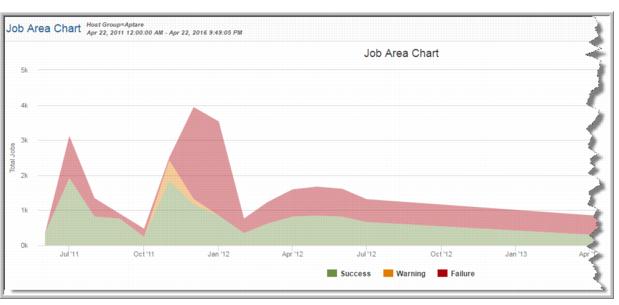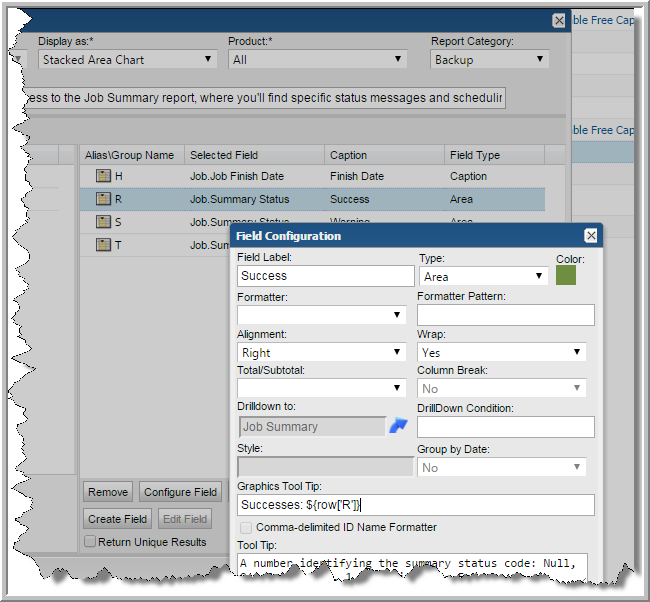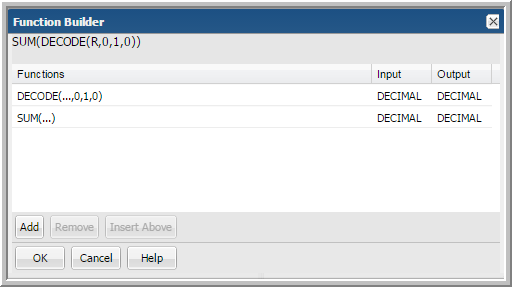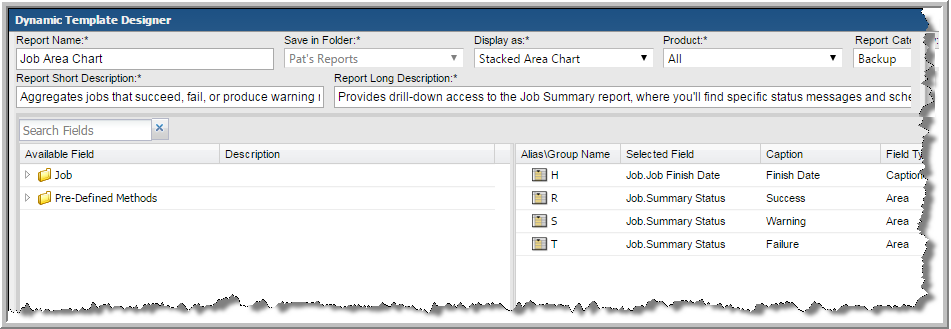Configure an Area/Stacked Area Chart Dynamic Template
Area/Stacked Area Chart Dynamic Template Step 1: Create a Dynamic Template
For this example—creating a report template for daily backup job status—you start with a Job enterprise object.
2. In the Dynamic Template Designer, enter text or select options at the top of the window.
Be sure to select
Display as Area/Stacked Area Chart. See also,
Type: Display as Area.
3. In the Dynamic Template Designer, expand the folders in the left panel and drag the following fields into the Selected Fields panel at the right. Note that as you drag fields into the selected panel, an Alias Name gets assigned to the field. As you remove and add fields, these alias names do not get reused.
• Job Finish Date - This provides the time component of the chart. The dates are used for the x-axis labels.
• Summary Status - In the description for this field, you’ll see that the summary status lists the explicit codes that denote the success or failure of a backup job. For the purpose of this example, we’ll be using three Summary Status fields to display Success, Warning, and Failed status.
Area/Stacked Area Chart Dynamic Template Step 2: Configure Basic Field Functionality
1. Double-click the Job Finish Date field in the Selected Fields panel and configure as shown:
• Formatter = Date Group By (This formatting is required in conjunction with the Group By Scope Selector setting to group values by the selected date.)
2. Double-click the Summary Status field and configure as follows:
• Field Label = Success
• Type = Area
• Color = Green
3. Drag two additional Summary Status fields into the panel and configure each to represent the Warning and Failed backup job status bars.
Area/Stacked Area Chart Dynamic Template Step 3: Configure Functions for a Field
Each of the Summary Status fields require two functions:
• DECODE, which detect and differentiate the status values, create counters for the status so that the number of backup jobs for the particular status can be tallied.
• SUM, which sums the number of backup jobs per status.
1. In the selected fields panel, select the Summary Status field that you’ve defined to represent the success status.
2. Click the Functions button at the bottom of the panel.
3. In the Function Builder window, click Add.
4. Select DECODE returns Decimal from the drop-down list of functions.
Note that only functions relevant to the selected field will be available. The majority of these functions are Oracle functions that enable you to manipulate values.
5. In the Function window, two mandatory parameters and one optional parameters must be configured.
• For the first Decimal, click in the Value cell and enter a 0. (Recall that in the description of this field, 0 = Success.)
• For the second Decimal, click in the Value cell and enter a 1.
• Click Add in the Optional Parameters section and enter a value of 0.
• Click OK to save the DECODE function’s configuration.
This configuration tells the system that whenever a zero is encountered for a job summary status, make it a 1 so that it can be added to the count of successful jobs; then, any other status will be set to 0 so that it will not get counted in this status.
6. Configure similar settings for the Warning Summary Status field:
• For the first Decimal, click in the Value cell and enter a 1. (Recall that in the description of this field,
1= Warning.)
• For the second Decimal, click in the Value cell and enter a 1.
• Click Add in the Optional Parameters section and enter a value of 0.
• Click OK to save the DECODE function’s configuration.
7. Configure similar settings for the Failed Summary Status field, where the DECODE parameters will be 2, 1, 0.
8. For each Summary Status field, click Functions and select SUM returns Decimal.
Area/Stacked Area Chart Dynamic Template Step 4: Define the Scope Selector
1. At the bottom of the Dynamic Template Designer window, click Define Scope Selector.
2. In the Scope Selector Components window, check Group By.
This setting must be selected so that the data can be grouped rather than enumerated for every time value. When the user runs this report template, a Group By selector will be available to choose the time grouping: Hours, Days, Weeks, Months, Quarters, or Years.
3. Click OK to return to the main Dynamic Template Designer window.
Area/Stacked Area Chart Dynamic Template Step 5: Save and Run the Report Template
1. In the main Dynamic Template Designer window, click OK to save your work. Your final report template window should look something like this:
2. Find your report template in the
Reports window and run it to check your results. The end result should look similar to the following report.






